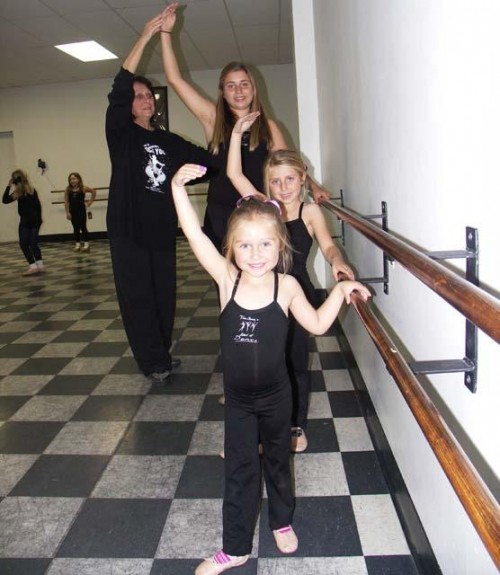Tuesday, Dec. 13
December 13, 2011
Hubert P. Rivere
December 15, 2011There is more that Tina Chauvin wants her students to learn than artistic skills associated with ballet, tap, jazz, lyrical, hip hop, tumbling or other dance steps. She wants them to learn to believe in themselves while developing responsibility and personal discipline that will benefit their lives.
Chauvin got her start at the age of 6 when she joined other neighborhood children in Houma whose parents paid 25 cents a class for them to get a little culture, exercise and entertainment on the dance floor. “As the years went on, I was the only one that stuck with it until now,” she said.
The dance instructor explained that taking formal steps on stage or simply enjoying a fais do-do is traditional in south Louisiana. It is also a discipline that can develop not only a talent but also integrity.
“It is important to people here,” Chauvin said. “I just feel like that more and more. Even though [the economy] is supposed to be tough, people keep putting their kids in dancing school. It is part of our culture.”
Chauvin said her business has flourished while other outlets that might not be considered necessities have experienced an economic pinch. Current enrollment for this dance studio is at nearly 400 students with ages that range from 2 to adult. When the studio is at capacity and students are unable to wait for an opening, Chauvin helps direct families to other teachers.
People stand in line to become part of Chauvin’s dancing school, which offers a variety of lessons with rates that range from $40 a month for individuals to family rates of $70 a month.
“Our dance school is doing wonderful and we have a waiting list for next year,” the instructor and business owner said.
In addition to learning dance, Chauvin noted that the benefit of becoming proficient in the arts enables children to develop confidence and social presentation skills. “It helps them be able to get up and say their names and not be fearful,” she said. “This studio is not just about dance. It is about each individual and what they can do.”
Chauvin speaks highly of all her students regardless of age or capabilities. She noted one almost 10-year-old student, Mally Theriot, with Down syndrome, who has benefited from dance school in that she has learned to be responsible and do what is expected just as any other child under this instructor’s direction.
“Not knowing that I could work with someone who is handicapped and seeing how she has progressed has been rewarding to me,” Chauvin said. “When I see her smile and see her parents smile and see each student who I would not have thought would take the time to help a child like her do so … these kids working with her has taught us a whole new ballgame.”
“I think the biggest benefit [for Mally] is that she is with other children her age,” said Britt Theriot of his daughter’s participation in dance school. “It’s just amazing to us how she can memorize all those dances.”
Ballet is where Chauvin begins her students before moving them into less disciplined genres. “Hip hop is a big thing right now, but I won’t do just a hip-hop class,” she said. “It’s not that I’m against it because I love every form of dance, but you can do that on the streets. It’s fun for the kids, but they need to be exposed to more than just that.”
While students at the Chauvin School of Dance participate in competitive events that range from local performances to multi-state showings, their teacher said they do not compete just to compete.
“School and religion come first to me,” Chauvin said. “Then comes dancing. If I watch a child and they are doing the best shuffle they can, then that is the best shuffle I’ve seen. That’s what it is about for me.”
Another element beyond the actual art is managing the business end of any day. “The hardest thing about running a business is if you have a family,” Chauvin said. “When your children need you the most is the hardest thing. In a business like this, the challenge is to making it fun [for students] and making them feel comfortable.”
Chauvin said that she has learned to adjust her thinking in terms of a work schedule because of her business hours. “I’m on when everybody else is off,” said.
In addition to teaching students on a given afternoon and evening, or participating in weekend competition, Chauvin and her staff of instructors are thinking a year ahead in terms of what is new and next for the studio. “Keeping up with the times and making sure they have something new and fresh all the time is important,” Chauvin said in terms of having a business model.
Dancing school and competition hits its stride with recital season in May and June. “If you get married in May, I’m not going to be there,” Chauvin said. “That’s our biggest time of the year.”
Add to the recital season, holiday parades, special appearances and contests, and the serious dancer’s calendar year becomes full faster than you can two-step.
“I’m all for competition,” Chauvin said. “Competition is healthy in the fact that it makes the children strive to be better. That is where it is a good thing. It is when the teacher gets too involved and a trophy is all that matters [that problems arise]. We have trophies, but a smile is a win to me. A hug is a win to me.”
Chauvin wants adults to understand the importance of children being involved in something constructive and being present once they commit to an activity. “Once you put them in, they have to show up, just like soccer or anything else,” she said. “They are part of a team.”
Dance is a skill participants are able to develop and enjoy for as many years as they desire. Chauvin confirmed that whether for competition, performance or simple entertainment, this artistic discipline is a step that enhances life.
Instructor Tina Chauvin teaches Chauvin School of Dance students Riley Hamilton, 4, Logan Hamilton, 6, and Regan Chauvin, 12, more than steps and positions. Chauvin says she teaches discipline, responsibility and confidence as well as the art of dance. MIKE NIXON









